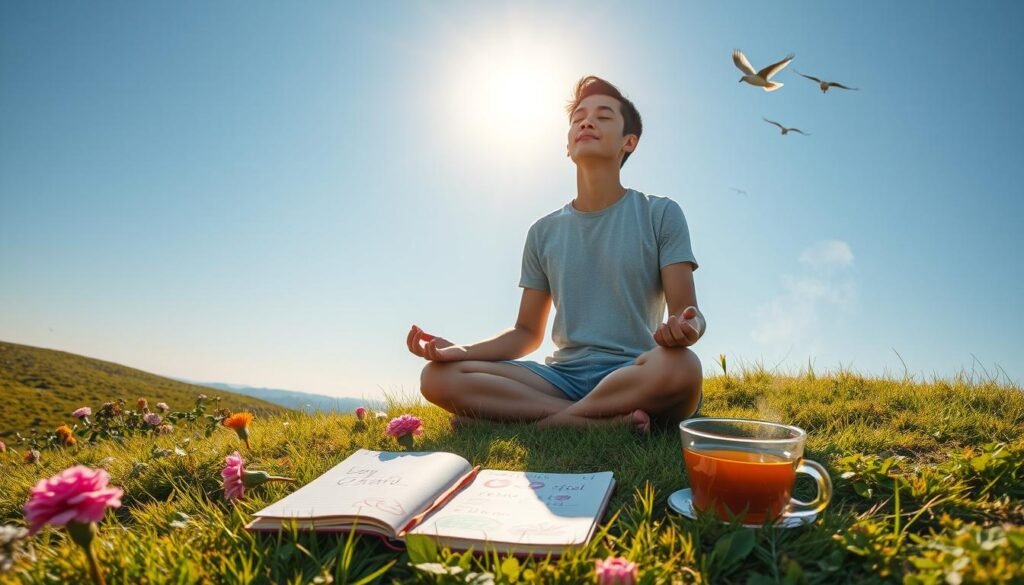Have you ever noticed how focusing on the negatives can drain your energy and magnify stress? What if there was a simple, science-backed way to flip the script and invite more positivity into your life? Enter the transformative power of gratitude. Gratitude practices can be game-changers, improving mental health and boosting relationships. They help notice small wins in daily life, creating a web of well-being that strengthens over time.
Starting a gratitude practice involves observing and acknowledging moments of thankfulness, even in small interactions. Robert Emmons, a psychology professor at the University of California, Davis, identifies two key components: affirming good things received and acknowledging others’ roles in providing goodness.
Key Takeaways
- Gratitude practices can significantly improve mental health and strengthen relationships.
- Recognizing small wins and moments of thankfulness can create a positive feedback loop.
- Gratitude involves appreciating the good things in life and acknowledging the role of others.
- A consistent gratitude practice can lead to lasting transformations in your outlook and well-being.
- Gratitude practices are simple to implement and can be customized to your unique needs.
Understanding the Power of Gratitude
Gratitude is a powerful emotion that can change your life in big ways. Studies show it boosts your immune system, improves sleep, and makes you feel more optimistic. It also helps you feel less lonely. By focusing on the good things in your life, you can make your brain happier and less stressed.
The Science Behind Gratitude and Well-being
Research shows gratitude is good for your mind and body. When you say thank you, your brain makes happy hormones like dopamine and serotonin. This makes you feel better, makes you stronger, and helps you get along with others better.
How Gratitude Affects Mental Health
Gratitude is key to better mental health. It helps you see the good in life and fight off bad thoughts. It makes you feel more positive and can help with depression and anxiety. It also makes you feel more content and happy with your life.
Benefits of Regular Gratitude Practice
Adding gratitude to your daily routine can make you feel better all the time. Some benefits include:
- Strengthened immune system
- Better sleep quality
- Increased optimism and positive emotions
- Reduced feelings of loneliness and isolation
- Stronger relationships with loved ones
By making gratitude a habit, you can enjoy these benefits and see a big change in how you think and feel about life.

“Gratitude is not only the greatest of virtues, but the parent of all the others.”
– Cicero
Getting Started with Daily Gratitude Practices
Starting a grateful living journey can change your life in big ways. It’s all about creating a daily habit that reminds you of the good things in your life. Begin by keeping a gratitude journal and take a few minutes each day to think about what you’re thankful for.
If you’re looking for an easy and effective way to start, the Good Days Start With Gratitude Journal is a highly recommended option. It provides simple prompts to guide your reflections and make gratitude a consistent part of your routine.
Think about the tough times you’ve been through and how far you’ve come. Ask yourself three key questions: What have I received from others? What have I given to others? What troubles have I caused others? This simple routine can help you feel more grateful and positive.
Use reminders throughout your day to think about what you’re thankful for. Stick notes, inspiring quotes, or phone alerts can help. Make a promise to yourself to be grateful, and you’ll be more likely to keep it.
Change how you talk by using words that mean gifts, blessings, and plenty. This change in how you speak can help you see the world in a more positive light, focusing on grateful living.

“Gratitude is the healthiest of all human emotions. The more you express gratitude for what you have, the more likely you will have even more to express gratitude for.”
– Zig Ziglar
Building a consistent gratitude practice takes time and effort. Be kind to yourself and don’t get down if you miss a day. The long-term benefits of a positive mindset through grateful living are worth the hard work.
The Art of Gratitude Journaling
Gratitude journaling has a rich history, offering a way to live life twice. You can experience the present and reflect on it. It’s available in both physical and digital formats, enhancing your appreciation for daily joys.
Choosing Your Journaling Method
Gratitude journaling is flexible. You can use a paper journal, a diary, or a digital document. Try different methods to find what suits you best.
What to Write About
In gratitude journaling, focus on small, often missed moments. Write about quiet moments, cozy beds, or clear skies. These everyday blessings help you feel more thankful and appreciative.
Best Times for Journaling
Find the best time for gratitude journaling in your day. Some start with reflection, while others end with it. Choose a time that fits your routine and lets you fully enjoy the practice.
“Gratitude journaling has been a transformative practice in my life, allowing me to pause, reflect, and truly appreciate the abundance all around me.” – Sarah, Gratitude Enthusiast

Gratitude journaling can change your life’s perspective. It helps you connect with the good moments and blessings. This leads to more joy, resilience, and connection with the world.
Mindful Appreciation Through the Senses
Developing a gratitude mindset helps you face life’s ups and downs with a positive mindset. One great way is to focus on your senses and appreciate the little things all day.
Begin by taking a few deep breaths. Use your breath to stay present. As you breathe, notice the sights, smells, sounds, and textures around you.
- Look around and find things you’re thankful for. Think about the work and skill that went into making them.
- Inhale deeply and enjoy any nice smells. Say thanks for the natural scents.
- Listen to the sounds around you. From birds chirping to machines humming, appreciate their role in your life.
- Touch different surfaces. Feel their textures and qualities.
Keep this coping with stress and positive mindset by saying thanks to those who help you. By noticing and appreciating the small wonders, you build a deep sense of gratitude. This can change how you see the world and improve your well-being.
“Gratitude unlocks the fullness of life. It turns what we have into enough, and more. It turns denial into acceptance, chaos into order, confusion into clarity… It can turn a meal into a feast, a house into a home, a stranger into a friend.” – Melody Beattie

The gratitude mindset isn’t just for big moments. By noticing and valuing the small wonders, you build a strong sense of thankfulness. This can help you get through tough times.
Building Stronger Relationships Through Gratitude
Showing heartfelt thanks can really help make your relationships stronger. It’s about saying thanks to those who support you, writing letters of gratitude, or sharing moments of appreciation. These actions can make your connections deeper and help you understand each other better.
Expressing Thanks to Loved Ones
Make sure to thank the people closest to you. Saying thanks for their help, support, or just being there can strengthen your bond. Grateful people are happier, healthier, have stronger relationships, and are more resilient in tough times.
Writing Gratitude Letters
Writing letters to thank those who’ve made a big difference in your life is a kind gesture. It could be someone you know well or a famous person who inspired you. Gratitude is linked to higher well-being at any age.
Creating Meaningful Connections
- Share your gratitude with a partner or friend to keep each other motivated and accountable in your appreciation practices.
- Actively listen and engage with your loved ones, as “Listening actively is highlighted as a crucial act of gratitude in relationships, particularly in our current era dominated by technology and distractions.”
- Offer surprise acts of appreciation, such as a thoughtful gesture or a spontaneous expression of gratitude, to create a sense of warmth and care in your relationships.
By adding gratitude to your relationships, you can build stronger bonds. You’ll understand each other better and appreciate the people who make your life richer. 
Morning and Evening Gratitude Rituals
Starting a daily gratitude practice can change your life for the better. By doing morning and evening rituals, you can move from stress to gratitude. This improves your mental health and emotional well-being.
Begin your day by thinking about what you’re thankful for. It could be your home, the food you’re about to eat, or time with family. Studies show that those who practice gratitude are 28% less stressed, Dr. Robert Emmons found.
At night, think about the good things that happened during the day. Write in a gratitude journal about the moments, people, or small things that made you happy. This simple act can make you happier, help you sleep better, and increase mindfulness. Friends have found texting each other three things they’re thankful for at night works well.
Try adding gratitude meditation to your morning or evening routine. Imagine the things, people, or events you’re thankful for. This can lower blood pressure, boost your immune system, and make you more resilient, studies have shown.
Whether you start or end your day with gratitude, these simple steps can greatly improve your life. Embrace thankfulness and see how your life changes for the better.
Cultivating Gratitude During Challenging Times
Having an attitude of gratitude isn’t just for the good times. It’s especially helpful during tough moments. By focusing on what we’re thankful for, we can find hope even when things seem darkest.
Finding Light in Difficult Moments
It’s easy to get stuck in negative thoughts when things get hard. But, by looking for small blessings, we can change our view. Appreciate your health, the people who support you, or the simple things in life. Recognizing these small joys can lift our spirits.
Transforming Negative Thoughts
Gratitude can change how we see and deal with tough times. Instead of focusing on what’s wrong, try to see the good. Ask yourself, “What am I thankful for right now?” This can help you stay hopeful and strong.
Building Resilience Through Appreciation
Gratitude doesn’t mean ignoring problems; it’s about seeing the good amidst them. By appreciating what’s positive, even when things are tough, we build inner strength. This practice can change how we face challenges and help us grow stronger.
“Gratitude can transform common days into thanksgivings, turn routine jobs into joy, and change ordinary opportunities into blessings.” – William Arthur Ward
The attitude of gratitude isn’t about ignoring our struggles. It’s about seeing the good in them. By practicing gratitude, we can cope with stress and reduce anxiety. This way, we come out of hard times stronger and more thankful for life.
Creating a Gratitude-Focused Environment
Making your space a place of gratitude can change your life. By adding reminders and practices, you can make gratitude a part of your day. This not only makes you feel better but also inspires others to be thankful too.
Start with visual cues that remind you to be grateful. Try a gratitude jar to write down things you’re thankful for. Or, use a digital app to track your blessings. These reminders help you remember to appreciate the good things in your life.
It’s also key to be around people who love the little things. Talk about gratitude with your friends and family. This way, you create a circle of people who value being thankful.
Think about making a “gratitude corner” in your home. Decorate it with things that make you feel thankful. This special spot can be a place to relax and think about all the good things in your life.
“Gratitude unlocks the fullness of life. It turns what we have into enough, and more. It turns denial into acceptance, chaos to order, confusion to clarity.” – Melody Beattie
By making your space a place of gratitude, being thankful becomes a natural part of your life. This approach can greatly improve your mental, emotional, and physical health. It helps you live a life full of joy and contentment.
| Gratitude Practice | Benefits | Implementation |
|---|---|---|
| Gratitude Jar |
|
|
| Gratitude Board |
|
|
| Gratitude Corner |
|
|
By using these gratitude practices and making your space a place of gratitude, you’ll see the world in a new light. Remember, gratitude is a personal journey. So, make these practices fit your unique needs and style.
Incorporating Gratitude Meditation
Discover the amazing power of gratitude meditation to deepen your appreciation for life. This simple practice can change your brain, helping you face challenges with more strength. It also helps you think more positively.
Start by setting aside a few minutes each day for mindfulness and gratitude. Begin with your breath, focusing on the present moment. Think of people, experiences, or things you’re truly thankful for. Let these feelings fill your body.
Imagine sending waves of gratitude to these subjects. Picture how your appreciation can positively affect them. This practice can make you feel happier, reduce anxiety and depression, and improve your overall well-being.
Gratitude meditation is a powerful tool for personal growth. Regular practice can change your brain, preparing you for future challenges. Let gratitude guide you on your journey.
| Gratitude Meditation Benefits | Research Findings |
|---|---|
| Improved mood and mental well-being | Studies have shown gratitude meditation can decrease symptoms of anxiety and depression. |
| Increased resilience and post-traumatic growth | Practicing gratitude can rewire the brain, helping individuals better handle future challenges. |
| Enhanced feelings of happiness and compassion | Gratitude meditation has been proven to increase feelings of happiness and compassion for self and others. |
| Better sleep quality | The practice of gratitude meditation has shown potential benefits for overall well-being, including improved sleep quality. |
Adding gratitude meditation to your daily routine can be incredibly rewarding. Begin with small steps. Let this practice light your way to a more positive mindset and better well-being.
“Gratitude meditation has the power to rewire our brains, turning challenges into growth opportunities and fostering a more positive outlook on life.”
Making Gratitude a Lifestyle Choice
Gratitude is more than a fleeting feeling or a holiday tradition. It’s a powerful tool that can change your life when it becomes part of your daily routine. By embracing grateful living, you can enjoy the lasting benefits of a thankful mindset. This can also spread positivity in your community.
Sustainable Gratitude Habits
To make gratitude a lifestyle, start with gratitude affirmations and habits that stick. This might mean a daily gratitude reflection, sharing thanks with family each week, or keeping a gratitude journal. The goal is to find activities that fit easily into your day. This way, cultivating gratitude becomes second nature.
Long-term Benefits and Growth
Practicing gratitude regularly can greatly improve your mental and physical health. Studies show it can help you sleep better, feel happier, and even strengthen your immune system. It can also lower depression, anxiety, and chronic pain. As you keep cultivating gratitude, you’ll grow personally, become more resilient, and find more meaning and joy in life.
Community Impact
Gratitude’s effects go beyond just benefiting you. When you share your grateful living with others, you inspire them to do the same. This creates a chain reaction, building a community filled with appreciation and positivity. As more people cultivate gratitude, we can all work together to make our social world better. We’ll form stronger bonds and feel more connected.
Choosing gratitude as a lifestyle is a bold step towards personal and community change. By building lasting habits, seeing the long-term gains, and sharing your grateful living with others, you unlock gratitude’s full potential.
Conclusion
Incorporating gratitude into your daily life can change you in amazing ways. You can keep a gratitude journal, do thankfulness exercises, or start appreciation rituals. These actions help you focus on the good things in life.
By making gratitude a regular part of your day, you’ll see big benefits. You’ll feel better mentally, have stronger relationships, and see the world in a more positive light.
Start your day with a gratitude ritual or reflect on your blessings at night. Doing this regularly can change how your brain works. Gratitude can make you happier, reduce stress, and improve your life in many ways.
Gratitude is not just a feeling; it’s a skill you can grow. Start your gratitude journey and let it become a big part of your life. As you keep practicing, you’ll see how thankfulness can change your world in amazing ways.



